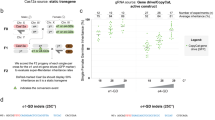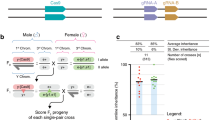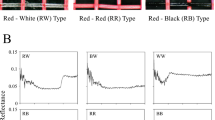Abstract
Area-wide pest management technologies will take on new appearances as the drive to eliminate and/or greatly reduce the use of chemical pesticides increases. The use of genetically altered insects has the most potential for successfully displacing certain pesticides, although the development of genetic engineering technologies for agricultural pest species is still in its infancy. Transformation vectors need to be developed as do transformation methodologies. Here we report the possibility of developing an interspecies vector and discuss ways in which such a vector could be used successfully in an integrated pest management system. If such an approach were developed, it could be utilized with other alternative methods, thereby providing a safe, ecologically sound means of controlling insect pests without damaging the agricultural economy
This is a preview of subscription content, access via your institution
Access options
Subscribe to this journal
Receive 12 print issues and online access
$209.00 per year
only $17.42 per issue
Buy this article
- Purchase on Springer Link
- Instant access to full article PDF
Prices may be subject to local taxes which are calculated during checkout
Similar content being viewed by others
References
LaChance, L. E. 1979. In: Genetics in Relation to Insect Management, p. 8–18. Hoy, M.A., McKelvey, J. K., (Eds.). Rockefeller Found Press, NY.
Pal, R. and Whittenn, M. J. (Eds.). 1974. The Use of Genetics in Insect Control. Elsevier, Amsterdam.
Whitten, M. J. 1979. In: Genetics in Relation to Insect Management, p. 31–40. op. cit.
Wright, J. W. and Pals, R. (Eds.). 1967. Genetics of Insect Vectors of Disease. Elsevier, Amsterdam.
Heilmann, L. J., DeVault, J. D., Leopold, R. L. and Narang, S. K. 1993. In: Genetic Applications to Arthropods of Biological Control Significance, p. 167–188. Narang, S.K., Faust, R. A., and Bartlett, A. M., (Eds.). CRC Press, Boca Raton, FL.
Georgiev, G. P. 1984. Mobile genetic elements in animal cells and their biological significance. Eur. J. Biochem. 145: 203–220.
Mount, S. M. 1992. Diversity among Drosophila transposable elements and their effects on gene expression, p. 99–112. In: Mechanisms of Eukaryotic DNA Recombination. Gottesman, M. E. and Vogel, H. J. (Eds.). Academic Press, San Diego, CA.
Goldberg, M. L., Sheen, J., Gehring, W. J. and Green, M. M. 1983. Unequal crossing-over associated with asymmetrical synapsis between nomadic elements in the Drosophila melanogaster genome. Proc. Natl. Acad. Sci. USA 80: 5017–5021.
DeVault, J. D., Hughes, K. J., Johnson, O. A., Leopold, R. A. and Narang, S. K. 1995. Stable transformation of corn earworm embryos with the Drosophila melanogaster hobo element. Proc. Natl. Acad. Sci. USA Submitted
Atkinson, P. W., Warren, W. D. and O'Brochta, D. A. 1993. The hobo transposable element of Drosophila can be cross-mobilized in houseflies and excises like the Ac element of maize. Proc. Natl. Acad. Sci. USA 90: 9693–9697.
DeVault, I. D. and Narang, S. K. Transposable elements in lepidoptera: hobo-like transposons in Heliothis virescens and Helicoverpa zea. Biochem. Biophys. Res. Comm. 203: 169–175.
Rubin, G. M. and Spradling, A. C. 1982. Genetic transformation of Drosophila with transposable element vectors. Science 218: 348–353.
Leopold, R. A., Hughes, K. J. and DeVault, J. D. 1996. Using electroporation and a slot cuvette to deliver plasmid DNA to insect embryos. Genet. Anal. Tech. Applicat. In press.
Hughes, K. J., Narang, S. K., Johnson, O. A., Leopold, R. A. and DeVault, J. D. 1996. Transient gene expression in Helicoverpa zea embryos. Insect Biochem. Molec. Biol. In press.
Adang, M. J. and Binns, A. N. 1988. A new era of systemic pesticides genetically engineered in plants, p. 249c. In: Proc. 18th Intern. Cong. Entomol. Vancouver, B.C., Canada, July 3–9, 1988.
Finnegan, D. J. and Fawcett, D. H. 1986. Transposable elements in Drosophila melanogaster. Oxford Surveys on Eukaryotic Genes 3: 1–62.
Berg, D. E. and M. N. Howe (Eds.). 1989. Mobile DNA. ASM Press, Washington, DC.
Finnegan, D. J. 1992. Transposable elements. Curr. Opin. Genet. Devel. 2: 861–867.
Robertson, H. M. and Macleod, D. H. 1993. Five major subfamilies of mariner transposable elements in insects, including the Mediterranean fruit fly, and related arthropods. Insect Molec. Biol. 2: 125–139.
Robertson, H. M. 1993. The mariner transposable element is widespread in insects. Nature 362: 241–245.
Calvi, B. R., Hong, T. J., Findley, S. D. and Gelbart, D. H. 1991. Evidence for a common evolutionary origin of inverted repeat transposons in Drosophila and plants: hobo, activator, and Tam3. Cell 66: 465–471.
Doak, T. G., Doerder, F. P., Jahn, C. L. and Herrick, G. A proposed superfamily of transposase genes: Transposon-like elements in ciliated protozoa and a common D35E motif. Proc. Natl. Acad. Sci. USA 91: 942–946.
Fryxell, K. J. and Miller, T. A. 1995. Autocidal biological control: a general strategy for insect control based on genetic transformation with a highly conserved gene. J. Econ. Entomol. 88: 1221–1232.
Author information
Authors and Affiliations
Rights and permissions
About this article
Cite this article
DeVault, J., Hughes, K., Johnson, O. et al. Biotechnology and New Integrated Pest Management Approaches. Nat Biotechnol 14, 46–49 (1996). https://doi.org/10.1038/nbt0196-46
Issue Date:
DOI: https://doi.org/10.1038/nbt0196-46



